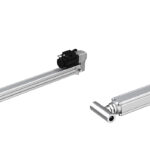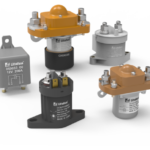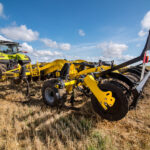By Geoff Schwartz | Business Development Manager • Littelfuse
Success in the global electric vehicle market depends on speed to market. However, it is also essential to prioritize quality and functionality, which enable a high-performance design that wins customer satisfaction. Understanding how to choose high-voltage DC relays can help keep off-highway vehicle designs safe and efficient.

Off-highway EV applications require knowledge on high-voltage DC relays to prevent safety risks and equipment damage. Image courtesy of Littelfuse.
While electrifying vehicle designs, engineers may encounter applications having DC voltages higher than they are used to seeing. At higher voltages (48 to 1800 V), a properly selected contactor can mean the difference between catastrophic failure and success. A proper system design will reduce the risk of a relay erupting, starting a fire, and disabling a critical function.
Engineers must understand relay technology, key specifications, and special problems of high-voltage DC applications. When selecting high-voltage relays for EV applications, engineers should consider levitation, coordinated circuit protection, make/break charts, polarization, and avoiding bi-stable relays.
Understanding the risk of levitation
Until recently, most vehicle designers have not had to plan for the phenomenon of levitation because it is rare in AC systems and at typical vehicle voltages. In electric vehicles and electrified vehicle systems, however, the need to switch higher levels of DC power increases the risk of levitation in contactors. Levitation can occur during an overcurrent condition when the magnetic field created by the current is so strong that it pushes the moving contact away from the stationary contact, creating arcing and chattering. These may damage the relay to the point of catastrophic failure.
This unsafe event is a consequence of current beyond the specification for the relay. Engineers need to know the level of current that may cause levitation and ensure the circuit will open before current reaches that point. Engineers should also specify upstream circuit protection that will operate fast enough to prevent levitation in the relay.
Instead of a standard fuse, which is a thermal device that takes time to operate, a pyrotechnic safety module (PSM) offers high speed and can be a better option. Because of the higher cost, PSMs are usually limited to protecting the main battery disconnect.
Choosing coordinated circuit protection
Circuit protection that is coordinated with a relay offers a balance between relay nuisance tripping and excessive contact arcing. In some high-voltage applications, a typical 4 to 5 msec differential might not be fast enough. Engineers should obtain relevant data from their suppliers to coordinate circuit protection with the relay.
In addition, the relay and fuse combination should be tested to verify strong protection without nuisance tripping.
Using the make/break chart
The higher the voltage, the more arcing will occur and the longer the arc lasts. So, relays with higher voltage ratings require larger contactor surface area and more robust construction, which means they tend to cost more and be physically larger. Engineers can reduce cost and size by specifying a relay with a lower nominal or continuous rating if the relay will experience a higher-than-rating voltage only rarely. This is the case if the relay doesn’t open or close with a load on it or the vehicle is usually shut down before the relay is opened.
For example, an engineer can safely specify a nominal 500 V or 800 V relay if it will see 1000 V only a few times throughout its operation compared to thousands of operations at 500 V. In application, the relay might make or break a connection at 1000 V only 50 times in its operational lifespan.
While the maximum voltage rating is the ceiling, designers can trade voltage ratings for duty cycles. To help make this decision, designers can consult the manufacturer’s make/break chart, which shows the number of make/break cycles a relay will perform at each voltage and current combination.

Design engineers can use a make/break chart to estimate a relay’s cycles for give voltage-current combinations. Image courtesy of Littelfuse.
Taking advantage of polarization
Polarized relays have optimized magnetic blowouts that maximize arc quenching. Permanent magnets on the sides of the contact chamber create magnetic fields that bend the arc. By causing the arc to travel a longer distance, resistance is increased, and the arc extinguishes faster.
Polarization significantly improves the make/break capability and cycle life, giving polarized contactors double the cycle life of non-polarized contactors in high-voltage applications.
Because they are designed to work with current flowing from the positive input to a negative output, if the polarized relay opens on a circuit with the current reversed, cycle life is significantly reduced. Therefore, a non-polarized contactor is appropriate in applications where the current flows frequently in the reverse direction. Nevertheless, a polarized DC contactor is usually the better choice for EV applications greater than 350 V.

Polarized relays use magnets to bend the arc, which increases resistance because the arc travels a longer distance. A pair of contactors divide the arc current in half. Image courtesy of Littelfuse.
Avoiding bi-stable relays in high-voltage applications
While designing an EV, a great deal of engineering is concerned with energy efficiency. Consequently, design engineers want to select relays that minimize energy consumption. However, selecting a bi-stable (also known as latching) relay in high-voltage applications adds additional risks.
When a latching relay loses coil power or ground when closed, it can stay latched in the closed position. This can cause a dangerous situation where the function controlled by the relay won’t stop, and life-threatening voltage is still in the circuit even when the control has turned the power to the relay off.
A monostable relay, in contrast, automatically opens when the power is removed. Any other relay style in most high-voltage DC applications is a greater safety risk. Electronic coils, such as dual coils and pulse width modulated coils, reduce the power draw of the safer monostable coils.
Increasing speed to market safely
Designers can create fast solutions that safely speed time to market and simplify the sourcing of multiple components. Deep knowledge of high-voltage and automotive applications can help engineers make safer designs and get to market faster.
Littelfuse
littelfuse.com
You may also like:
Filed Under: NEWS • PROFILES • EDITORIALS, Off highway • construction • agriculture, Relays









